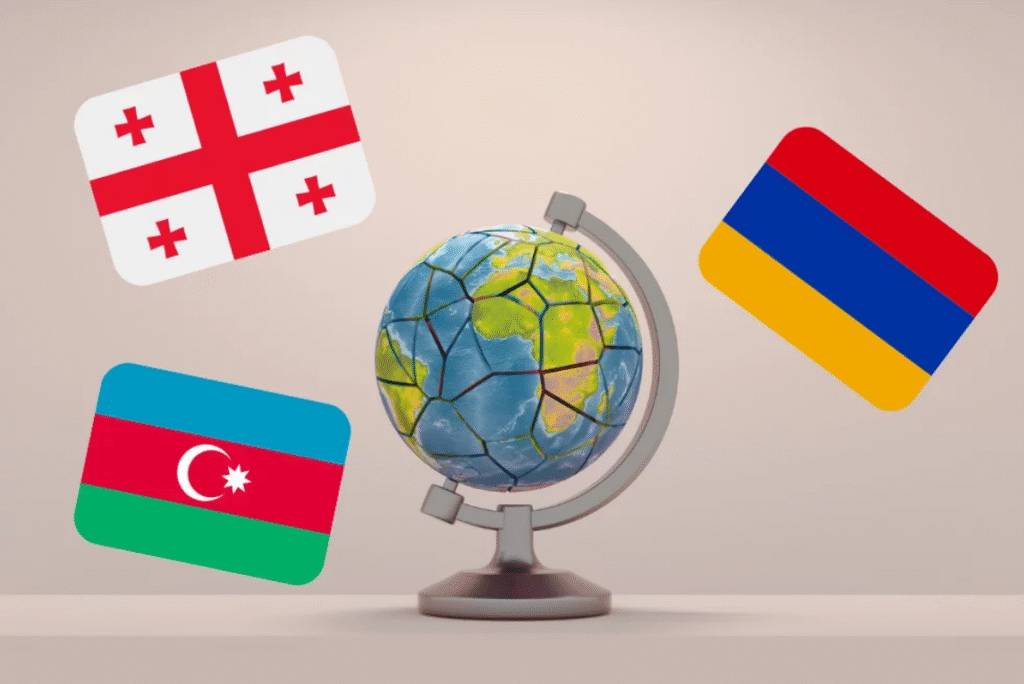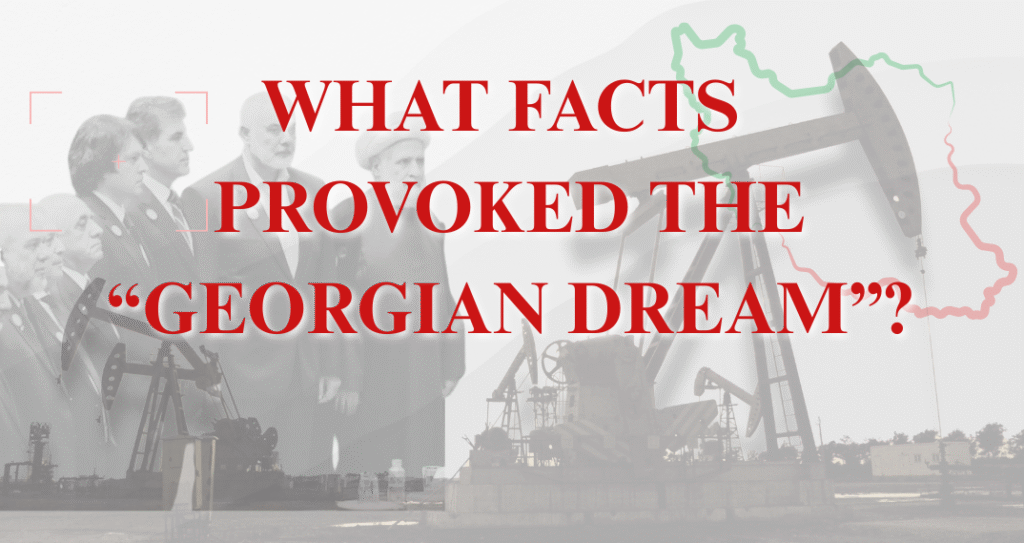Tinatin Khidasheli’s article published by Heinrich Böll Stiftung
This analysis explores whether competing trade corridors can foster stability or entrench authoritarian bargains, and asks a central question: can there be lasting stability in the South Caucasus without resilient, democratic states at its core?
This time, the spotlight was not on Georgia. It was Armenia’s prime minister, on 30 August, flying over Azerbaijani territory. In one carefully choreographed flight, nearly 30 years of entrenched hostility and closed borders gave way to a gesture of normalization. Yet the event marked more than symbolism: it followed a recent US–Armenia strategic partnership adopted in January 2025, significant financial assistance pledged by US Secretary of State Marco Rubio, and earlier that month, on 8 August in Washington, the signing of the TRIPP corridor initiative.[1]
The symbolism of the prime minister’s flight and the substance of Washington’s renewed engagement cannot be separated. Together, they could be seen as the South Caucasus, long dismissed as a peripheral theatre of post-Soviet contestation, having gained momentum to re-enter the sphere of interest for the United States. The TRIPP corridor, envisioned as a secure, transparent route connecting Armenia and Azerbaijan and onward to the Black Sea, directly challenges, and creates yet another diversion from, the dominance of older, Russia-centric arrangements along with Baku-Tbilisi-Ankara negotiated routes. For Azerbaijan, reopening routes consolidates its role as a hub between the Caspian and the Black Sea. For Yerevan, it offers material and political support: a path out of isolation and toward a closer relationship with Western institutions.
Yet this new momentum also exposes the fragility of the region’s equilibrium. The TRIPP initiative and Armenia’s pivot toward Washington are not occurring in a vacuum. They intersect with Turkey’s activism, Iran’s determination to secure influence in its northern neighbourhood, Russia’s waning but still disruptive presence, and China’s interest in embedding the South Caucasus within its Belt and Road Initiative (BRI) agenda. We are also seeing the EU step forward. Brussels had already taken the lead in earlier rounds of mediation, deployed the EU Mission in Armenia (EUMA) and steadily expanded the EU–Armenia partnership across trade, governance and connectivity. Complementing diplomacy with concrete resources, the EU pledged additional financial support during high-level visits to Yerevan and Baku in late 2025, underscoring its readiness to anchor long-term stabilization in the region.
The result is a landscape of overlapping corridors and competing visions, in which the future of regional stability depends less on infrastructure itself than on the governance, security guarantees and alliances surrounding it.
For Georgia, these developments are both an opportunity and a warning. For three decades, Tbilisi has defined itself as the indispensable gateway between Asia and Europe: the only South Caucasus state with direct Black Sea access, the central transit corridor for Caspian energy and east–west trade, a consistent partner for Euro-Atlantic institutions, and the single most trusted ally of the US in the wider Black Sea-Caspian region. Yet Armenia’s sudden re-emergence on Washington’s agenda, anchored in the TRIPP agreement, inevitably raises the question: will Georgia’s primacy as the regional connector be diluted, or can it adapt and reinforce its role within a more diversified regional order?
Much depends on the future of how TRIPP is implemented and the turn the Georgian state will take coming out of the year-long crisis of legitimacy and recognition of its government. If TRIPP strengthens regional cooperation under transparent, rules-based conditions, Georgia may actually benefit, as greater connectivity through Armenia and Azerbaijan would still converge on Georgian ports and infrastructure. But if TRIPP evolves as a parallel route bypassing Georgia, or if Georgia’s strategic ties with the US and EU are broken, Tbilisi risks being sidelined at precisely the moment when its democratic credentials are under strain and its Western orientation has come into question. Georgia is risking it all, including its sovereignty and long-term security.
On the scale of today’s global crises, Georgia may not appear the most urgent problem. Yet history has already shown the cost of underestimating its importance. The failure to respond decisively to Russia’s aggression in 2008 sent a dangerous signal – that small states could be sacrificed without consequence. In international affairs, there are no ‘minor’ or ‘secondary’ theatres defined by the size of GDP or population of a given country; what matters is a strategic vision and credible deterrence. If Georgia is allowed to fail, it will not only be a national tragedy; it will be a victory for Putin’s Russia and, with it, a profound defeat for the rules-based international order and the democratic world.
Small space, big stakes
Despite its modest geographic scale, the South Caucasus concentrates a remarkable density of geopolitical tensions, making it one of the very contested spaces in the world. One might argue that it is not even a region, but rather a geography, as the three states – Georgia, Armenia and Azerbaijan – have no shared vision, common strategy or alliances. Wedged between the Black and Caspian Seas, and bordered by Russia, Turkey and Iran, it has long been a geopolitical pivot between empires and civilizations. Today, the region is at the heart of ambitious connectivity projects linking Asia and Europe. Once seen mainly through the prism of Russia, the South Caucasus now demands recognition as a regional system in its own right, with strategic consequences that extend far beyond its borders.
The South Caucasus might be one place where Russian disengagement, while it is busy fighting for its imperial ambitions in Ukraine, has altered long-established power structures and interstate relations. Azerbaijan restored its territorial integrity through a rapid military campaign that triggered the mass displacement of Armenians from Nagorno-Karabakh and created a profound humanitarian crisis, while Russia effectively deserted Armenia. The move brought change not only for Azerbaijan but also fractured Yerevan’s long-term loyalty and reliance on Russia, which had promised to safeguard the security and defence of Armenians. Once considered Moscow’s ally and a trustworthy partner in the region, Armenia is turning its back, edging toward normalization with Azerbaijan and Turkey – a move potentially leading to the reopening of long-blocked trade routes. A survey published in March 2024 showed a sharp decline from 87% to 31% of those who thought that Armenia–Russian relations were good or very good. Although very important, it is not enough for a long-term and sustainable change in political alliances. The reconciliation process with Azerbaijan and Turkey remains fragile. Legacies of mistrust, unresolved security concerns and Russian attempts to insert itself as a guarantor all complicate the picture. Connectivity may help normalize relations, but it is no substitute for genuine conflict resolution. There is a long way for Armenia to go to prove the irreversibility of the course Prime Minister Pashinyan took so courageously.
The South Caucasus has become a testing ground for whether competing visions of connectivity can deliver stability or merely reproduce geopolitical fragmentation. Thus, at the centre lies a critical dilemma: can the South Caucasus achieve long-awaited stability without consolidating resilient democratic institutions? Or will connectivity projects, however ambitious, become tools of authoritarian influence if detached from governance and the rule of law?
Connectivity and competition
Connectivity has always been more than transport infrastructure; it is about who sets the rules, who controls the rents and whose security guarantees underpin the flows. In the South Caucasus, different actors envision very different futures.
The priority for the United States and the EU is building transparent, secure and sanctions-compliant routes that diversify away from Russia and integrate with Euro-Atlantic standards. The proposed Black Sea submarine cable and efforts by the Georgia-American consortium around the Anaklia deep-sea port in Georgia are examples of projects designed to strengthen resilience through transparency and Western financing. Unfortunately, the Anaklia project was killed off by Georgia’s most powerful oligarch, Bidzina Ivanishvili, and we are still waiting to see progress on the BS Submarine Cable Project. To be crystal clear, the middle corridor matters for the West as much as it offers a real alternative to being politically blackmail free, rules predictable, and based on partnership and mutual benefits. If Russia fully controls Georgia or Armenia under TRIPP, the middle corridor loses its power of real alternative and free transit space, thus becoming useless for the West.
For Russia, the region remains part of its self-declared sphere of influence. Moscow’s interests lie in retaining veto power: whether through its military bases, control of energy chokepoints, peacekeeping presence in Nagorno-Karabakh or establishing control over the regime in Tbilisi. Russia does not oppose connectivity per se, but insists that flows remain dependent on Moscow’s consent, thereby preserving leverage over small neighbours.
China’s goals are more business-oriented than political, but no less consequential. Beijing views the South Caucasus as a helpful link in its BRI, particularly as alternative routes gain importance due to Western sanctions on Russia. Chinese companies have been involved in port, railway and highway projects, often with opaque terms. The challenge is that such projects risk reinforcing authoritarian practices rather than strengthening resilience if not bound by transparency standards.
Turkey has emerged as perhaps the most dynamic regional actor. As a NATO member, a strategic ally of Azerbaijan and an increasingly assertive broker, Ankara sees the South Caucasus as a security buffer and an economic opportunity. Reopening transport routes between Azerbaijan and Armenia, including through the Zangezur Corridor / Syunik province,[2] would significantly bolster Turkey’s east–west connectivity ambitions. Ankara’s role, however, is double-edged for the three states of the South Caucasus. If aligned with Euro-Atlantic standards, Turkey could be a stabilizing force that embeds the South Caucasus more firmly in Western security structures. If, instead, Turkey leans into a transactional approach, privileging bargains with Russia and Iran under the 3+3 format,[3] the democratic dimension of connectivity might be lost.
Iran also sees an opportunity. Tehran supports the 3+3 initiative as a way to assert influence in its northern neighborhood and counterbalance Western projects. It also understands that its position in the region is uneven: while it maintains meaningful political and economic ties with Armenia, its influence in Georgia and Azerbaijan is marginal, either politically or economically. Thus, supporting the 3+3 platform provides a certain leverage for Tehran to be involved, gain alliances and partnerships, find new partnerships and opportunities and complicate the strategic geometry of the region by reinforcing the authoritarian tilt of the 3+3 format.
The much-pushed 3+3 format is not good news for the West. It is not about transparency or rules-based governance, but about regional rivals – Turkey, Russia and Iran – recognizing that situational alliances are necessary to shield their interests and preserve dominance in the South Caucasus, thus securing alternative trade routes. By working together, they aim to blunt the influence of the United States, the European Union and even China, while keeping Western actors at arm’s length. Rather than stabilizing the region, this arrangement risks entrenching authoritarian practices and sidelining democratic aspirations. When we say Georgia matters, its refusal to join the 3+3 arrangement is evidence of standing alone in resisting a framework that undermines US/EU interests. This is precisely where Western engagement becomes critical. Without substantial investment and higher-level political commitment – whether through bilateral partnerships or ambitious regional projects – the geopolitical vacuum will be filled by powers whose vision for the South Caucasus runs directly against Western interests and values.
Conclusion: beyond corridors, partners to defend
The South Caucasus is more than a transit space. It is a contested region where connectivity, power politics and governance collide. Competing visions, Russia’s coercive dominance, China’s expansion under the BRI umbrella, Turkey’s brokerage of an ambitious 3+3 initiative, Iran’s balancing and constant repositioning in search of its spheres of dominance, and renewed Western focus on Black Sea security all intersect here. We are witnessing a continual redrawing of the region’s security and connectivity maps.
The decisive factor for whether the redrawing will result in stability, however, will not be the number of railways or pipelines laid but the governance structures and security guarantees underpinning them. Without democratic resilience, connectivity risks becoming a vector of authoritarian capture, and thus completely useless. This article argues that there is no sustainable stability in the South Caucasus without strong, sovereign and democratic states at its core. Without strong institutions, connectivity can easily entrench corruption, empower oligarchs and provide authoritarian states with new levers of influence.
The region stands at a crossroads. Whether it becomes a corridor of stability or a zone of permanent contestation will depend on Georgia, Armenia and Azerbaijan’s ability to consolidate sovereignty and democracy in an increasingly turbulent world. In the South Caucasus, institutions, governance structures and quality vary, but challenges are shared. For decades, the Georgian people were the most vocal in democratic aspirations, though domestic backsliding and political polarization threaten its credibility. Armenia, shaken by war and crisis, is now taking visible steps toward democratic reform and a more Western orientation. The intentions appear serious and encouraging since the 2018 revolution, yet it is still too early to judge whether these efforts will translate into durable results. Azerbaijan has consolidated power in a more authoritarian mold, with connectivity serving as an instrument of state control.
Thus, for Western actors, the lesson is clear: investing in infrastructure without governance safeguards risks reproducing ‘business as usual’. Connectivity must be designed not only to move goods and capital but also to strengthen democratic institutions and states. The stakes extend beyond the South Caucasus. In fragile regions worldwide, infrastructure can either anchor states to a rules-based order or bind them into dependency on authoritarian patrons. The South Caucasus is a test case: if Western actors fail to integrate governance safeguards, they will weaken regional stability and lose credibility in the global contest over standards and influence. It should mean conditioning financing on transparent procurement, aligning projects with EU standards and ensuring that benefits reach societies rather than entrenching oligarchic elites. Otherwise, Western efforts will merely replicate the authoritarian bargains they aim to counter.
Now, when the South Caucasus is at the heart of great-power competition again, the region needs, yet lacks, a real champion. For decades, Georgia had an ambition of being that champion, driving democratic change in the South Caucasus and beyond, and being both the indispensable transit hub and the most reliable partner of the West. Georgia’s role is critical under any scenario. The Black Sea coast makes Georgia the only South Caucasus state with direct European access. Excluding or weakening Georgia would fragment the notion of an alternative for east–west routes in the middle corridor.
Put differently, there is no durable stability in the South Caucasus without a strong and sovereign Georgia. Georgia’s ports, pipelines and cables form the indispensable bridge between Caspian resources, Asian markets and European consumers. It is also an existing South Caucasus transit hub, with the Baku-Tbilisi-Ceyhan (BTC) oil pipeline, the South Caucasus gas pipeline and the crucial Middle Corridor trade route, which connects Europe to Central Asia through the Black Sea, all running through Georgia. If Georgia falters, the South Caucasus risks sliding fully into authoritarian spheres of influence.
Now, because of the ruling elite’s authoritarian drift and its growing submission to Moscow, Georgia is being sidelined, reduced from a strategic actor to a passive bystander in a game it once helped define. However, the Georgian people have proved loyal to their country’s historic choice of EU and NATO integration. The US and EU need genuine partners in the region, and there is every reason to believe that, regardless of today’s power crisis, Georgia stands as a firm and loyal ally. Fragile though it may be, it remains the region’s strongest anchor to Euro-Atlantic institutions. This resilience stems from the strong will of the Georgian people: even an anti-democratic, anti-Western ruling elite cannot cross certain red lines without provoking a harsh response from society. This is why Western partners should be strong and decisive in their support for the fight of the Georgian people. With consistent Western backing in its democratic struggle, Georgia can overcome the current crisis, restore its strategic role and re-emerge stronger and more resilient – once again at the centre of the South Caucasus and an indispensable pillar of the rules-based international order.
The views and opinions in this article do not necessarily reflect those of the Heinrich-Böll-Stiftung European Union | Global Dialogue.
This text builds on discussions held by the “Expert Delegation on Global Power Shifts” (funded by Heinrich-Böll-Foundation). With a focus on geopolitics, China and the role of the EU, the week-long event took place in Brussels in the early summer of 2025. It brought together academics and practitioners from the foundation’s global network.
[1] Signed in the White House on 8 August 2025, this is a peace deal between Armenia and Azerbaijan, backed by the US. Washington will have leasing rights to develop the transit corridor, which would connect Azerbaijan with its exclave, Nakhchivan, and rebrand it to the Trump Route for International Peace and Prosperity (TRIPP). The project will operate under Armenian legal jurisdiction, but the United States will lease the land to a private US company to oversee construction and management. Negotiations to decide who will operate the corridor will begin next week.
[2] We use both terms for neutrality purposes. Zangezur Corridor is the term used by Azerbaijan and Turkey, framing it as a strategic corridor connecting mainland Azerbaijan with Nakhchivan, and further with Turkey. It implies an extraterritorial passage with special status. Syunik province is how Armenia refers to it, stressing that these are domestic roads inside its sovereign territory, not a “corridor” under someone else’s control. International discussions often reference Zangezur Corridor, so readers will recognize the name. At the same time, explaining that it lies within Armenia’s Syunik province gives the geographic fact and reminds readers of Armenian sovereignty.
[3] The ‘3+3’ format is a regional cooperation platform proposed by Turkey and Azerbaijan in 2020, bringing together the three South Caucasus states (Armenia, Azerbaijan and Georgia) and their three neighbors (Turkey, Russia and Iran). Georgia has refused to participate due to Russia’s occupation of Abkhazia and South Ossetia, so in practice the platform functions more as ‘3+2’.




